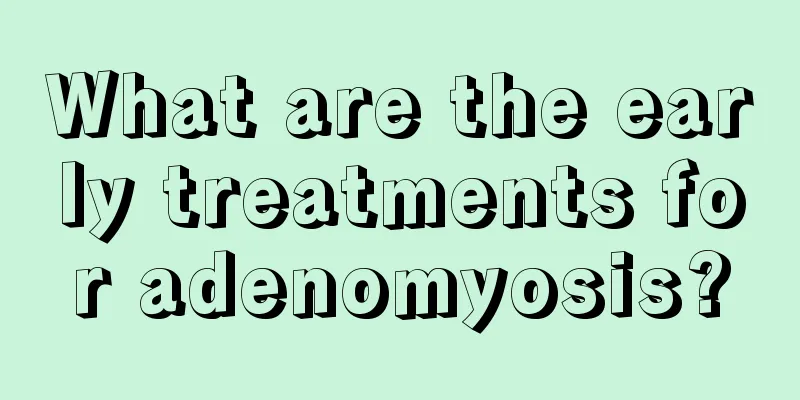What are the early treatments for adenomyosis?

|
A child is the fruit of a family and the main bond that maintains a family. However, there are still many women who are infertile, which tests how every family deals with this serious problem. Everyone should know about early treatment of adenomyosis, because adenomyosis is one of the causes of infertility, so we must take it to heart. Next, let us learn about the methods of early treatment of adenomyosis. Adenomyosis, also known as intrinsic endometriosis, is a special type of endometriosis in which the endometrium invades the myometrium of the uterus. Dysmenorrhea is the main symptom of adenomyosis. Adenomyosis and adenomyoma are not early reactions of cancer. There is currently no specific drug treatment. The most effective treatment is surgery. The lesion presents interlaced thick strips of muscle fibers and fiber bands, with dark red bleeding spots or small areas appearing among them. Few polypoid endometrium can protrude into the serosa, and endometrial glands and stroma can be seen in tissue sections. For patients with adenomyosis who no longer have fertility requirements, it is better to have a total hysterectomy and keep the ovaries as much as possible. If there is pelvic endometriosis, the lesions should be removed as much as possible to retain ovarian function, so that the patient can go into natural menopause. For those who want to have children, hormone treatment can be used for 6 to 12 months, and the medication can be stopped in the hope of conception in the short term. If it is discovered during surgical exploration, the adenomyoma should be removed and the uterus should be retained. The surgery preserves the ovaries, but removes one of the two blood supply pathways to the ovaries, so the ovarian function may be slightly affected. The short-term effects after embolization are generally good, but half of the patients will relapse after a few years, because the body's natural repair function will cause the lesions to form collateral circulation. However, for people over 40, especially after 45 years old, ovarian function gradually declines, so even if it relapses, it will not be very serious. 1. Medication (1) Symptomatic treatment: For patients with mild symptoms who only require relief of dysmenorrhea, nonsteroidal anti-inflammatory drugs such as ibuprofen, indomethacin or naproxen can be used for symptomatic treatment during dysmenorrhea. (2) Pseudopregnancy therapy is used for patients with mild symptoms, no desire to have children, and those near menopause. Oral contraceptives or progestins can cause the ectopic endometrium to decidualize and atrophy, thereby controlling the development of adenomyosis. (3) For women with heavy menstrual flow, dysmenorrhea, and no desire to have children, an intrauterine device containing highly effective progestin can be chosen. It continuously releases progestin locally in the uterus to control the development of ectopic lesions and needs to be removed or replaced after five years. (4) Pseudomenopause therapy ("medical oophorectomy" or "medical hypophysectomy"): drugs that shrink the lesions before surgery and reduce recurrence after surgery. GnRHa injection makes the hormone level in the body reach the menopausal state, thereby causing the ectopic endometrium to gradually atrophy and play a therapeutic role. The application of GnRHa can significantly reduce the size of the uterus and can be used as a preoperative medication for some patients with larger lesions and difficult surgeries. If you wait until the uterus becomes smaller before performing surgery, the risks and difficulty will be significantly reduced. Side effects may cause menopausal symptoms and even serious cardiovascular and cerebrovascular complications and osteoporosis. Therefore, it is recommended to add estrogen in reverse after 3 months of GnRHa application to alleviate complications. In addition, GnRHa is expensive, so it is not currently used as a long-term treatment option. Once the drug is stopped, the resumption of menstruation may lead to further progression of the disease. After reading about the early treatment of adenomyosis, do you have a certain understanding? As a woman, you must frequently surf the Internet to learn about uterine issues, because you never know when all kinds of bad and serious consequences will occur. When that day comes, it will be too late to regret, and for many people it is irreversible. In any case, we should protect our health, cherish ourselves and learn to take care of ourselves, so that we can work and study happily. |
<<: What are the early symptoms of adenomyosis?
>>: How to treat endocrine disorders in women?
Recommend
"Doctor, help!" It turns out that we have been deceived by this sentence in TV dramas for so many years
The weekend dinner was hosted by a family member....
Causes of abdominal pain after menstruation
Many female friends will experience abdominal pai...
What to do if pregnant women have oral pain
Ordinary people should use medications with cauti...
Can I eat instant noodles during confinement?
The emergence of instant noodles has indeed broug...
What should women do if they have a urinary tract infection and experience abdominal pain after urinating?
Urinary tract infection is a disease that many pe...
How can women delay aging?
Although time is merciless and people's faces...
Does ectopic pregnancy have anything to do with sperm?
Many people always attribute ectopic pregnancy to...
Is Bartholinitis Surgery Painful?
Bartholinitis can have adverse effects on the pat...
What harm does abortion do to the human body?
Abortion is a surgery that women often undergo, m...
Appendectomy in the era of minimally invasive surgery
In the medical field, the development of minimall...
What should I pay attention to when my daughter has her first period?
When a daughter has her first menstruation, we sh...
I bleed every day after taking Yasmin
I bleed every day after taking Yasmin. Is it norm...
There is still bleeding after more than ten days of curettage
The body cannot recover so quickly after uterine ...
What happens if you eat spicy food after abortion?
After an abortion, in order to better restore hea...
3 types of precancerous lesions and 5 types of inducing factors, these 8 groups of people should be careful about oral cancer!
Author: Yu Guangyan, Chief Physician, Peking Univ...









